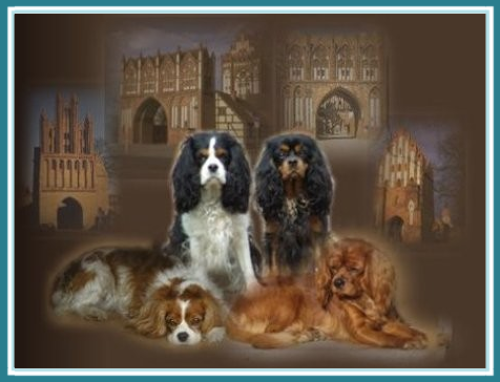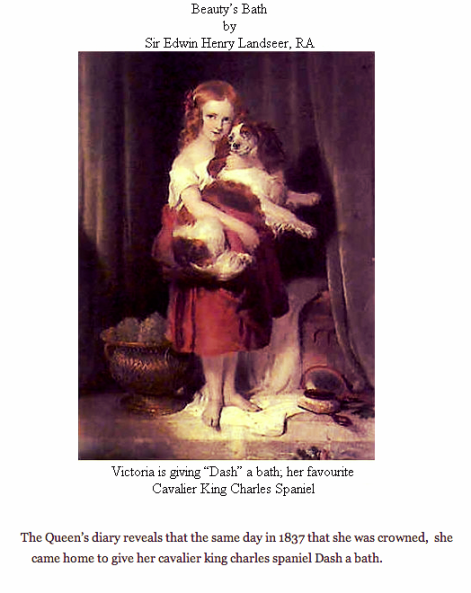CAVALIER KING CHARLES SPANIEL
The History of Cavaliers
Small spaniels have been popular companion dogs for hundreds of years. They were found in royal courts and noble homes in Spain (where the spaniel gets his name), France, England and Scotland and were often prominently featured in their owners’ portraits. The Scottish Stuarts were especially fond of the little dogs. Mary, Queen of Scots had a toy spaniel by her side when she was executed, as did her descendant, England’s King Charles I. It was Charles and his son Charles II who lent their name to the dogs that eventually became known as Cavalier King Charles Spaniels.
The toy spaniels’ popularity began to wane after a new king, William, replaced James II (also a Stuart) on England’s throne. William was from Holland, and he favored Pugs. People began crossing the Pugs and spaniels, and eventually their look changed, becoming more flat-faced with a domed head. Dogs like the ones seen in old portraits practically disappeared, except for a few lines here and there, like the ones kept by the Churchill family at Blenheim Palace. The dogs might have faded into the past except for one Roswell Eldridge, a wealthy American who offered a prize to anyone who could produce a dog like the ones he had seen in 17th and 18th century paintings.
British breeders took up the challenge and rebuilt the breed, working with long-nosed English Toy Spaniels (called King Charles Spaniels in England). The first of the “new” spaniels was exhibited in 1928 at Crufts Dog Show. Alas, Eldridge did not live long enough to see him, but his estate paid the prize. Since then, the Cavalier has evolved to what he is today: a sturdy and highly popular companion, combining bird-dog nosiness and Toy-dog affection for people.
The Cavalier ranks 23rd among the breeds registered by the American Kennel Club, up from 54th in 2000. That’s one of the largest leaps in popularity in the past decade.
7 FACTS ABOUT THE CAVALIER KING CHARLES SPANIEL
1. They’ve Got A Brand New Claim To Fame
Kind of feel like any Cav lover could have told the world this without a research team BUT...A team of scientists recently
declared the Cavalier King Charles Spaniel as being the furthest removed physically from the wolf! The
breed was also found to be the most removed characteristically from the wolf. Cavs showed only two of the
nine aggressive behaviour patterns and none of the six submissive ones that were in the wolf (Huskies showed all 15!).
According to the research, this breed never matures much beyond a wolf puppy of 20 days old for its entire life and stays in what’s called a neotenic state (AKA
Peter Pan mode!) for life. So, basically their genetic make-up is that of an actual love sponge that would rather snuggle than argue for pack leader status. I'm cool with
that.
2. They're Professional Companions
Nicknamed “The Comfort Spaniel”, Cavalier King Charles Spaniels were bred keep the laps of the Queens of England toasty warm in drafty
castles and on chilly carriage rides. They were with them day in and day out as little buddies while their husbands were at war. While many other breeds no longer perform the tasks they were
bred for, cavaliers still take their responsibility pretty fluffin' seriously.
In the breed’s early years, Cavs were often brought into beds, which was verrrrry uncommon at the time. They were meant to attract fleas and be bitten
instead of their owners, thus saving their humans from the plague or other diseases! Champs.
3. The Ladies Call The Shots
With Cavalier King Charles Spaniels, it is the females that establish dominance hierarchies! The males just go along with the flow and do as
they’re told. Pretty magical if you ask me!
Two female Cavaliers in the same household will generally have some issues with dominance, but two males will not. A one male one female pair will not have dominance issues either, as the male will
likely not challenge his lady’s authority. #whoruntheworld
4. They’re Named After King Charles II
They go way back. King Charles II, who lived and ruled England in the 17th century, was an extremely devoted fan of the toy spaniels that came to be named after him. The King put forth a law that said no King Charles Spaniel could be barred from any public place, not even the House of Parliament, where animals otherwise were forbidden. Absolutely amazing, and still in place today!
King Charles II was obsessed with Cavs and he became known for allowing the little dogs to follow him everywhere, always accompanied by at least three. It was documented that the King was so fixated on his dogs that he was accused of ignoring the issues of his kingdom. The struggle was real.
5. There’s A Legend Behind The Blenheim’s Forehead Spot
Legend has it that while the Duke was away fighting the Battle of Blenheim, Sarah, the Duchess of Marlborough, was worried sick that he husband may not return. She sat in the garden with a pregnant Cavalier on her lap and stroked and caressed the mom-to-be, pressing her thumb on top of the spaniel’s head.
When the news arrived that the battle was won and the Duke was safe, the puppies were born! All of the tiny Cavalier Kings were marked with a chestnut-colored imprint of the Duchess’s thumb in the middle of their forehead. And there ya have it, the origin of the thumbprint found on the head of a perfectly marked Blenheim Cavalier!

6. The Pug Influenced Their Look But People Were Like "Noooooooo!"
After King Charles II passed away, the popularity of the breed began to fade and other dogs, like the pug, stepped into the spotlight. The King
Charles spaniel was bred with the pug, giving it a shorter snout and domed head. It was actually centuries later that breeders decided
they wanted to make the spaniel look the same way that it did when it was in just about all the former reigning monarch’s photos. They weren’t fans of the ‘pug’ in the dog.

7. Queen Victoria Was Just As Obsessed As The Rest Of Us
Queen Victoria had a tricolor Cav named Dash, who she was head over heels for. On the day of her coronation in 1837, she left the momentous event, changed her clothes and gave her little spaniel a bath.
The Queen commissioned dozens of artists and artisans to create images of Dash. Needlework, paintings and porcelain figures galore! When
Dash passed away, Queen Victoria herself wrote his epitaph:
"Here lies Dash, the favorite spaniel of Her Majesty Queen Victoria, by whose command this memorial was erected. He died on the 20th December 1840 in his
ninth year. His attachment was without selfishness, his playfulness without malice, his fidelity without deceit. Reader, if you would live beloved and die regretted, profit by the example
of Dash."








